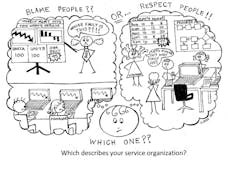A number of years ago, while consulting for a financial services company at the beginning of their lean journey, I was asked to help a business unit undergoing a serious—and seemingly sudden—productivity crisis. A meeting was arranged and the business unit’s senior vice president, managers and I gathered in a private conference room to review the situation. I could feel the tension as I walked into the room.
Projected on the wall was a new report that had been created by corporate reporting comparing the productivity of each team member in this business unit to all other team members in the organization. Looking at the report, it was obvious that this business unit’s team members’ productivity was one-third to one-half the productivity of other business units’ team members. The company president wanted to know why, and what the senior vice president and managers were going to do it about. Something needed to change and it needed to change now. Sound familiar?
After completing our review of the report, I asked the vice president and the managers the following questions: How do you know the numbers on the report are correct? Have you verified the information by sitting with each of your team members to see how the work is processed? And how do you, as managers, monitor throughout the day that the necessary amount of work to satisfy customers is being completed? Do you know how much work needs to be done each day to satisfy customers?
Looking at me in disbelief, the vice president and managers answered: Every morning we check yesterday’s productivity report. We discuss productivity in our weekly management meeting. Then we tell our team members what numbers they need to make for the next week. Why would we go and sit with them while they are working? We hire talented, experienced people for these jobs and provide ongoing training. They should know how to do their jobs. Why would we monitor team members’ work throughout the day? Managing workload and workflow is their responsibility. If they don’t get their work done, and the numbers aren’t met, that’s their fault. They must be doing the work the wrong way. Figuring out how to do the work and making sure it gets done isn’t our job. We do not want to be micromanagers…
Micromanagement. A word I hear over and over, yet often wonder if the people saying it even know what they mean. I have noticed some common themes when people talk about the “dreaded” micromanagement:
- It is telling team members what to do and how to manage work they should “already know how to do” and manage.
- It is viewed negatively by team members and managers alike. Team member: “I know how to do my work and I don’t need someone else telling me how to do it.” Manager: “My team members are responsible adults and should know how to get their work done. My job isn’t to manage how they do their work. My job is just to make sure it gets done and we meet our numbers. I wouldn’t want to disrespect people by micromanaging them.”
Over the years, and through helping teams in many service companies in situations similar to the one described above, I have come to understand that the fear of micromanagement seems to stem from a basic misconception of what management is all about. Most managers in non-lean service organizations that I have met believe that “management means managing people to do the work on time and correctly. If the work isn’t done on time and isn’t done right, someone is to blame.” Lean, however, teaches us that role of managers is to “manage the process so that team members can be successful.”
As Jeff Liker states in The Toyota Way, “the right process will produce the right results.” In the section on Principle 12: Go and See for Yourself, the Japanese concept of Hourensou—rapid go and see for managers—is explained. Actually three words, Hourensou means to report, to give periodic updates and to advise, and at Toyota, it is part of a manager’s number one responsibility: to develop people. And Toyota knows that managers cannot develop people if they do not know what people should be doing (the ideal state) and what they are doing right now (the current state).
When first experiencing this, one American Toyota vice president said he thought he was being “micromanaged” by the Japanese, but as he began to understand that they were pushing and nudging him in the right direction to develop him, he started trying it with the people he managed. And eventually he said he could not conceive of managing any other way. Imagine your golf teacher not bothering to watch and give feedback on how you swing the club as you are learning, but simply waiting to see the results of your next game. After all, why would they want to micromanage you while you are learning to play golf?
When we view management as a system to control people, then looking closely at what we do feels like too much control. When we conceive of management as teaching, then it is unimaginable that a manager would stay at arm’s length, only paying attention to team members when they are not making the numbers.
So how do managers in lean service organizations manage the process and teach, so that team members can be successful?
- They don’t rely on managing exclusively by using metrics produced somewhere else in the company.
- They know enough to have a clear picture of what should be happening to satisfy customers and have a clearly defined process that is shared with their team members.
- They regularly spend time in gemba (the place where the value-added work is being completed for customers) understanding how team members complete and process work compared to the defined process and the targets the whole team is working to meet.
- When observing team members doing actual work processes, they identify and work with team members to help solve the inevitable problems that occur in all processes and provide in the moment coaching to develop team members’ problem identification and solving skills.
- As a result of deep understanding of the process by which work is completed and constant monitoring of daily workload and workflow, they make capacity adjustments as necessary so that team members are not overwhelmed and overburdened, and so that individual and team targets and goals are consistently met.
- And, perhaps most importantly, the team has clear targets for improvement, or what Mike Rother in Toyota Kata calls “target conditions” or “process patterns” they are striving for. Visible to the whole team every day or even every hour is how they are doing compared to the target so that the team is creatively working to overcome obstacles to achieving the target condition.
Service processes are unbelievably complex and involve multiple decision points and team member interactions with customers, other team members, and a variety of computer systems. In service organizations managers who are skilled in lean thinking understand the challenge of achieving a desired state of performance and know that their job is to develop team members to creatively deal with the naturally occurring obstacles to performance. To continually improve the process and achieve successful service outcomes for customers, managers in service organizations must micromanage the process: that is, they must understand at least daily how they are doing compared to where they want to be.
Is your service organization respecting your team members by micromanaging your processes to develop your people’s improvement capability? Do you have a defined process? Are you continuously improving the process with your people? I guarantee that if you as a manager are doing this effectively, your team members are among the top performers that other teams are being compared to.
__________________________________
Join the Liker Leadership Online Community to access our webinars, courses, and consultants.
http://LikerLeadership.com/community.html
Liker Leadership Institute (LLI) offers an innovative way to learn the secrets of lean leadership through an online education model that is itself lean, and extends that lean education far beyond the course materials. Learn more about LLI’s green belt and yellow belt courses in “The Toyota Way to Lean Leadership” and “Principles of Lean Thinking” at the IndustryWeek Store.





